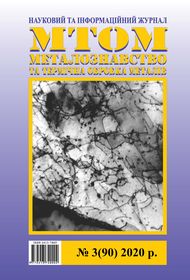DETERMINATION OF THE COEFFICIENT FOR EVALUATING THE OPERATION OF THE INSTALLATION USING SECONDARY HEAT
DOI:
https://doi.org/10.30838/J.PMHTM.2413.290920.35.667Keywords:
ventilation, coefficient, secondary heat, exhaust air, supply air, air conditioning, temperature, supply units, exhaust unitsAbstract
Raising of problem. If in different atmospheric conditions not only the temperature of the atmosphere but also the quality of the atmosphere must be taken into account, then both supply and exhaust ventilation must be taken into account. Simple systems often work as supply or exhaust systems. In this case, only supply air is given in the room, and return air passes through the joints in the presence of tightness or air is sucked out of the room, and the necessary pressure equalization occurs through air flows coming from outside the room through the walls. In order to use the system of secondary use of heat at the controlled supply and exhaust ventilation, it is necessary to mount both the exhaust installation and supply one. Particularly favorable is the combination of supply and exhaust manifolds, in which case you can avoid the intermediate coolant to supply heat from the exhaust air to the supply one. Each process of secondary use of heat is characterized by the fact that the heat comes from the exhaust air and is supplied to the supply air. Purpose. The purpose of this work is to determine the coefficient (indicator) of secondary heat, which allows the comparison of different systems of secondary heat use, if the mass flows are variable and the external energy demand is small. In the future, a new indicator of secondary heat should be introduced at constant mass flows and low external energy demand for existing definitions. Conclusion. To simplify the separation of the two possible options for determining the rate of secondary heat, take into account the air flow related to the heat transfer side as the return heat potential, and the heat receiving side − the potential of the heat input. As a broad concept of both forms, the concept of the coefficient of secondary use of heat should be used.References
Stefanov Yev.V. Ventilyaciya i kondicionirovanie vozduha : monografiya [Ventilation and air conditioning : monograph]. Saint-Petersburg : Avok North-West Publishing House, 2005, 400 p. (in Russian).
Cheylytko A.M. Vikoristannya vtorinnih energoresursіv : navch. posіb. [The use of secondary energy resources : textbook]. Zaporozhye : ZDIA, 2014, 246 p. (in Ukrainian).
Zakon Ukraїni «Pro kombіnovane virobnictvo teplovoї ta elektrichnoї energії (kogeneracіyu) ta vikoristannya skidnogo energopotencіalu» [Law of Ukraine “On combined heat and power (cogeneration) and the use of waste energy potential”]. Vіdomostі Verhovnoї Radi Ukraїni [Bulletin of the Verkhovna Rada of Ukraine]. 2005, no. 20, pp. 278; 285. (in Ukrainian).
Kurbatov Yu.L., Mass N.S., Kravtsov V.V. and Kasyutina T.G. Vtorichnye `energoresursy, `energotehnologicheskoe kombinirovanie i resurso`energosberezhenie : ucheb. posob [Secondary energy resources, energy-technological combination and resource-energy saving : tutorial]. Donetsk, 2011, 161 p. (in Russian).
Rukovodstvo po razrabotke `energeticheskogo pasporta potrebitelya `energoresursov proizvodstvennogo naznacheniya [Guidelines for the development of an energy passport for a consumer of industrial energy resources]. Coll. 3. Moscow : Moscow Agency for Energy Saving, 1997, 243 p. (in Russian).
Vagin G.Ya., Dudnikova L.V., Zenyutich E.A., Loskutov A.B. and Solntsev E.B. Ed. Sergeev S.K. `Ekonomiya `energoresursov v promyshlennyh tehnologiyah : sprav.-metod. posob. [Saving of energy resources in industrial technologies: Reference guide]. Nizhnyi Novgorod : NSTU, NITsE Publ., 2001, pp. 133, 193−196, 200−201. (in Russian).
Downloads
Published
Issue
Section
License
Authors that are published in this journal agree to follow the conditions:
Authors reserve the right to the authorship of his work and cede the right to the journal of first publication of this work on conditions of the license under the Creative Commons Attribution License, which allows others to distribute it freely with the obligatory reference to the author of the original work and the first publication of the work in this journal.

